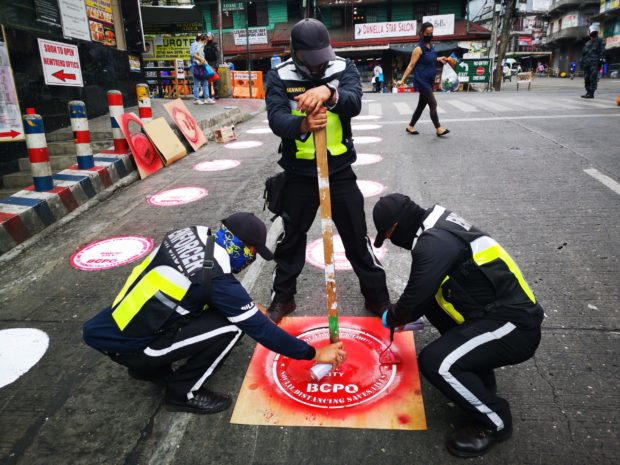
STREET MARKERS In Baguio City, markers spray-painted on a street leading to the public market ensure that people will obey physical distancing rules. The city is among the heavily populated areas in the country because of its reputation as among the top education and business centers in northern Luzon. —EV ESPIRITU
BAGUIO CITY, Benguet, Philippines —The National Economic and Development Authority (Neda) here has requested Malacañang to include key urban areas like Baguio, Cebu and Davao cities in the plan to return Metro Manila residents to their home provinces under the “Balik Probinsya” program.
The matter was raised on Tuesday after government economists observed that Metro Manila was classified in the program as the only urban center “and the rest of the Philippines as ‘probinsiya’ (its provinces),” said Dolores Molintas, assistant director of the Neda in the Cordillera.
During a management committee meeting at City Hall, Molintas said the observation would be tackled when the government laid down the program’s rules and regulations, including the identification of “secondary growth centers.”
Baguio Mayor Benjamin Magalong said the move was “good” but should not be rushed until local governments firmed up their economic fundamentals, given the impact of the Luzon lockdown that was meant to contain the spread of the new coronavirus disease (COVID-19).
Magalong said the city was not ready to take in more people unless a cure for COVID-19 was made available and until sufficient mass testing was undertaken to determine the extent of transmission.
Baguio plan
A plan for returning Baguio residents has been prepared once the city is placed under general community quarantine after May 15.
But the city government will still not allow people coming back from towns and provinces under enhanced community quarantine or even from countries where the virus has spread.
Residents who intend to come home may apply for permits through a web page that will be put up before the weekend.
But some workers had pretended to be residents just to return to Baguio to find jobs, according to the mayor’s aide, Philip Puzon.
Puzon said the local government should consider a proposal made by Police Col. Allen Rae Co, city police director, to set up checkpoints beyond city limits to enable medical staff members to screen people entering Baguio.
In the City of San Fernando, the Pampanga Chamber of Commerce and Industry (PamCham) has recommended “preliminary preparations” in the provinces before the Balik Probinsya program is fully implemented.
Pamcham wrote to the Regional Development Council, headed by Bataan Gov. Albert Garcia, suggesting that investments and jobs in the provinces should precede the relocation of people from Metro Manila.
PamCham president Renato Romero said transport and road infrastructure “must be ready to accommodate the expected increase in vehicle volume and number of commuters to prevent traffic congestion.”
Preparatory measures
The group proposed that “housing, schooling and medical facilities must also be readily available for relocating families” while “assurance of peace, order and safety in the business community should be guaranteed.”
“Lacking these critical preparatory measures, we worry that the program will not really solve the problems in Metro Manila but will merely disperse and transfer them to the provinces,” Romero said.
In Nueva Ecija province, a lawmaker said decongesting Metro Manila would require local governments to open new job opportunities. Unless the national government works with the local governments and the private sector to generate jobs, Rep. Rosanna Vergara said the program “will not be able to achieve its objective.”
Public-private partnership
“As an example, the government together with [beverage giant] San Miguel Corp. or [food producer] Dole Philippines, through a public-private partnership, can put up a canning or bottling factory in Cabanatuan City so that vegetables that are abundant during harvest season can be canned and marketed nationwide,” Vergara said.
“Before COVID-19 struck, excess [from the harvest of vegetables] like eggplants, green peppers and tomatoes went to waste because the cost of transport to Metro Manila was more expensive when the retail prices were too low,” she said.
—REPORTS FROM VINCENT CABREZA, TONETTE OREJAS AND ARMAND GALANG